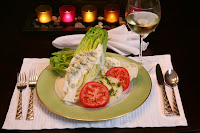In my opinion a well stocked spice shelf is a major part of a busy kitchen. There are so many spices available and each has their own use. I would have to say that depending on your nationality and how much you cook would be a determining factor on the amount of spices in your kitchen.there are some basic spices and herbs every kitchen should have. Most of the spices you get in a purchased spice rack are not necessarily the ones you might use most often. I myself do not consider flavored salts or meat rubs to be the most important items on the spice shelf.The three main spices that I believe no kitchen can be without are onions, garlic, and parsley. These three herbs can add flavor and variety to many of your favorite dishes. I use these three herbs just about every time I cook.
Beautiful, fragrant basil is prized throughout the world. It is used especially prominently throughout the Mediterranean, and in Thai and Vietnamese cuisines. It is the key ingredient in Italian pesto, a thick sauce made of basil, garlic, pine nuts, and olive oil, and in the similar French pistou. Basil is a great addition to soups, salads, and tomato sauces. It's also a great addition to fish, chicken, and cheese dishes.
Bay leaves hail from the Mediterranean, and are important in Greek, French, and Italian cookery. They are most readily available in dried form, usually as whole leaves. One or two leaves will add flavor to soups, stews, sauces, gravies, and stocks, and the leaves can be easily removed before serving. Crumbled or ground bay leaves work well in seafood, meat, or poultry dishes, and in bread stuffings.
Pepper is one of the most ubiquitous spices in the world, and black pepper is perhaps the most commonly used variety. Though pepper hails from India, and grows only in hot climates, it was so highly prized by ancient spice traders that it now features in virtually every cuisine. To showcase pepper's pungent bite, try using it to encrust steak, salmon, orgoat cheese, or use it generously in vinaigrettes. For best flavor, skip the pre-ground pepper, and invest in a pepper grinder.
Available in whole pod, seed, and ground forms, cardamom is a highly perfumed spice. Especially important in Indian and Arab cuisines, cardamom has both savory and sweet applications. It is a key ingredient in the Indian spice blend called garam masala. In Arab countries, it is also used to flavor coffee, tea, and pastries. A touch of cardamom is great in carrot dishes, in spice rubs for salmon, and in vanilla or chocolate cakes, cookies, and puddings.
Use dried, ground chiles, chile flakes, or fresh chiles to heat up soups, curries, stews, pasta dishes, vegetables, beans, stir fries, or cheese dishes. Fresh chiles are also great additions to salsa. Take care when handling fresh chiles -- the seeds and inner membranes carry volatile oils that can burn eyes or skin, so avoid touching them, or wear rubber gloves while cutting the chiles.
Warming and fragrant, cinnamon is one of the world's oldest known spices. In the US, its scent is so associated with comfort, that home sellers are advised to bake something with cinnamon during open houses. Americans and Europeans use cinnamon most often in sweets, baked goods, teas, hot cocoa and coffees. But in India, North Africa, the Mediterranean, the Middle East and Caribbean regions, cinnamon is used in savory dishes as well. Experiment with cinnamon in vegetables, stews, soups and rice dishes.
Strange as it may seem, coriander seeds, which are considered a spice, come from the cilantro plant, which is used as an herb. Stranger still, coriander has a sweet, clean, herbal fragrance that in no way resembles cilantro. Coriander is used in the Indian spice blend called garam masala, and is often used in chutneys and curries. It is also a popular addition to Middle Eastern and certain Asian cuisines. Coriander has a nice affinity for citrus, so try it in dishes that employ orange or lemon juice or zest, such as salads or fish dishes.
Cumin's pungent aroma is instantly recognizable to lovers of Indian, Mediterranean, and Middle Eastern cuisines. Available as whole seeds or ground spice, cumin lends a distinct flavor to curries, hummus, and falafel. Cumin is a good addition to grilled meats, bean dishes, and vegetables.
Curry powder is a blend comprised of spices native to India. In truth, India's vastly varied regional cuisine has given rise to countless such blends, called masalas. But the curry powder (so dubbed by British colonialists) most familiar to Westerners is generally a mix ofturmeric, paprika, fenugreek, coriander, pepper, cumin, ginger, celery seed, cloves, caraway, and red pepper. Curry powder may be most associated with Indian cuisine, but it also has an affinity for Southeast Asian and Caribbean cuisines.
Dill has a fresh, distinctive aroma that is especially prized throughout Europe and the Mediterranean. Its flavor brightens creamy or salt cured foods, such as cheeses or smoked fish. Both the dried seeds and fresh herb are integral in pickling. Try dill in omelets, with potatoes, baked into quick breads or tossed in salads.
Mediterranean in origin, there are hundreds of varieties of mint, which now grow throughout the world. Mint is used widely in Greek, Middle Eastern, North African, Indian, and Thai cuisines, where it's inclusion in savory dishes helps offset spicy notes. Mint's cooling properties are also appreciated in hot climates, both in food and as tea. In Europe and America, mint is more often used in sweet dishes, and as a flavoring for candies and toothpaste, and other breath fresheners. Mint is also valued medicinally for it's stomach soothing and anti-infective properties.













.jpg)








